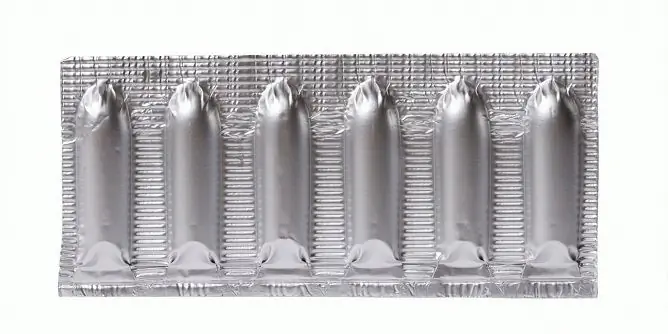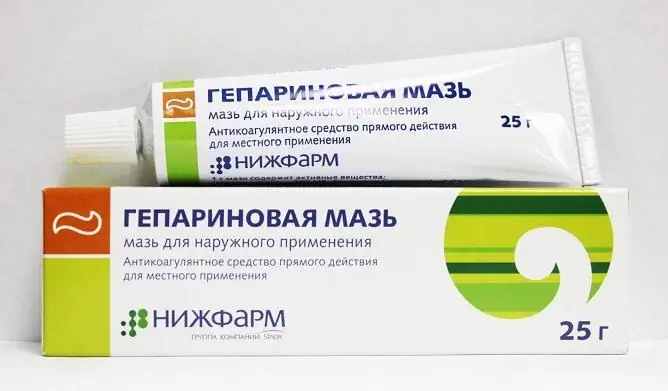- Author Rachel Wainwright [email protected].
- Public 2023-12-15 07:39.
- Last modified 2025-11-02 20:14.
External hemorrhoids
The content of the article:
- Causes and risk factors
- Forms of the disease
- Disease stages
- Symptoms of external hemorrhoids
- Diagnostics
- External hemorrhoids treatment
- Possible complications and consequences
- Forecast
- Prevention
External hemorrhoids are a pathological condition in which varicose veins of the rectum are observed. The pathological process causes stagnation of blood in hemorrhoids and the development of inflammation. Hemorrhoids are among the most common proctological diseases; according to various sources, it is diagnosed in 5-25% of the population. Both men and women are susceptible to the disease, but about 80% of all cases of hemorrhoids are recorded in males aged 30-60 years. The share of external hemorrhoids in the overall structure of the disease reaches 35-40%. External hemorrhoids in women often occurs during pregnancy (25-50% of all pregnant women) and in 80% of women in the postpartum period.

External hemorrhoids - varicose veins of the external hemorrhoidal plexus
Causes and risk factors
The main reason for the development of external hemorrhoids is stagnation of venous blood in the cavernous bodies of the rectum due to congenital or acquired weakness of the venous walls. Stagnation of venous blood leads to the expansion of the corpora cavernosa and the development of hyperplastic changes with foci of sclerosis in the vessel walls. With the progression of the pathological process, the longitudinal muscles of the rectum weaken, which, in turn, leads to an even more pronounced protrusion of the hemorrhoids.
An important role in the development of external hemorrhoids is played by a hereditary predisposition, namely, congenital weakness or dysfunction of the blood vessels, which is the cause of increased blood flow and insufficient outflow from the cavernous veins.
Among the factors that can provoke the appearance of external hemorrhoids, there are persistent constipation, the habit of pushing hard during the bowel movement, which causes a strong tension in the muscles of the perineum, and also increases the pressure in the hemorrhoids. In addition, chronic diarrhea contributes to the appearance of external hemorrhoids, which can cause irritation and inflammation in the rectal mucosa. Hemorrhoids can develop against the background of excessive physical exertion, a sedentary lifestyle, and work with prolonged static stress. At risk are representatives of such professions as movers, weightlifters, security guards, doormen, drivers, air pilots, teachers, programmers, office workers, hairdressers, etc.

External hemorrhoids often occur in women during pregnancy and in the postpartum period
The frequent formation of external hemorrhoids during pregnancy is due to physiological changes occurring in the woman's body during this period. The developing fetus presses on the inferior vena cava, resulting in stagnation of blood in the vessels with a subsequent increase in hemorrhoids. In addition, the protrusion of hemorrhoidal veins is facilitated by labor, in which intra-abdominal pressure sharply increases. Wearing tight belts, bandages, and overly tight clothing is another factor that increases the risk of external hemorrhoids in pregnant women.
Other risk factors include:
- diseases of the internal organs;
- Varicose veins;
- poor nutrition;
- the presence of bad habits (in particular alcoholism);
- too frequent use of enemas and / or abuse of laxatives;
- insufficient hygiene of the anal area, due to which the mucous membrane of the anal canal becomes irritated and inflamed;
- taking oral contraceptives;
- overweight;
- hobby for some types of physical activity (cycling, motorcycle, horse riding).
Forms of the disease
Depending on the localization of pathologically altered hemorrhoids, hemorrhoids are of the following forms:
- external - hemorrhoids are located outside the anus;
- internal - hemorrhoids are located inside the anal canal, practically invisible, in the later stages they fall out;
- mixed - the simultaneous presence of signs of both internal and external hemorrhoids.
External hemorrhoids, in turn, can be acute or chronic.
Depending on the characteristics of the course, external hemorrhoids can be complicated and uncomplicated.
Disease stages
In the development of external hemorrhoids, the following stages are distinguished:
- Hemorrhoids are practically invisible visually, are clearly distinguishable on palpation, there is a pronounced discomfort in the anal region.
- The inflammatory process in the hemorrhoids is accompanied by their increase, there is itching, burning, pain in the anus.
- Hemorrhoids increase to such a size that it becomes difficult for the patient to be in a sitting position, there is discomfort when walking, minor, but frequent bleeding.

Combination of internal and external hemorrhoids
Symptoms of external hemorrhoids
External hemorrhoids are rarely asymptomatic, but in some cases they may not cause significant discomfort. The location of pathologically enlarged hemorrhoids outside the anal canal is characteristic, the nodes arise in the cavernous vascular plexuses, which are localized around the sphincter. This form of the disease should be distinguished from internal hemorrhoids with prolapse of hemorrhoids from the anal canal to the outside. External hemorrhoids are covered with skin, and internal hemorrhoids are covered with mucous membranes.
Even before the appearance of hemorrhoidal cones, patients have early symptoms of external hemorrhoids: discomfort, itching, burning and irritation in the anal area. Pain in the anal area is usually associated with bowel movement, but it can also appear spontaneously. The pain is aggravated by prolonged sitting or standing, with prolonged physical exertion, sneezing, coughing, jumping and running.
As the disease progresses, the hemorrhoids around the anus enlarge. They have an elastic consistency, the patient can feel them independently. The appearance of traces of blood on toilet paper after defecation is noted, in addition, blood can also be found on linen, towels, etc. Severe bleeding for external hemorrhoids is not characteristic, however, with a significant increase in hemorrhoids in size, they are easily injured by dense feces, due to which often bleed. In addition, with external hemorrhoids, anal fissures often occur, which also leads to the release of blood during bowel movements and increased pain.

One of the symptoms of external hemorrhoids is traces of blood on toilet paper after a bowel movement
During the period of exacerbation, hemorrhoids become inflamed and swollen, which is also accompanied by severe soreness, while the body temperature can rise to febrile values. With a significant increase in hemorrhoids, the patient has a feeling of a foreign body in the anus.
In a state of remission, external hemorrhoids usually do not manifest themselves, in rare cases, the patient is worried about itching and discomfort in the anal region, and minor spotting may also occur.
Diagnostics
Diagnosis of external hemorrhoids is usually straightforward, since hemorrhoids are found during a visual examination of the anal area. As a rule, the nodes are painful on palpation. A cyanotic shade may indicate the development of thrombosis.
To clarify the diagnosis, anoscopy (an instrumental research method that allows you to visually assess the condition of the rectum) and sigmoidoscopy (an endoscopic method of examining the mucous membrane of the rectum and distal sigmoid colon) are performed. These methods make it possible to exclude the combined form of hemorrhoids, as well as neoplasms of the rectum and diffuse polyposis of the large intestine. If necessary, especially if a concomitant pathology is suspected, a colonoscopy (a method of endoscopic diagnosis of pathologies of the large intestine) is performed, as well as an irrigoscopy (an X-ray examination of the large intestine with a radiopaque contrast agent).

Anoscopy is one of the methods for diagnosing external hemorrhoids
If bleeding occurs, angiography is done to determine the source. Endorectal ultrasonography for external hemorrhoids makes it possible to assess changes both in the corpora cavernosa and in the adjacent blood vessels.
Laboratory diagnostics for external hemorrhoids is not very informative. The results of a general blood test usually indicate the presence of an inflammatory process, thrombosis is accompanied by a change in the coagulogram.
Differential diagnosis is required with internal hemorrhoids (prolapse of hemorrhoids), rectal prolapse, rectal polyps, hemangioma, paraproctitis (acute or chronic).
External hemorrhoids treatment
Conservative methods of treating external hemorrhoids are effective in the early stages of the disease, at later stages the main method is surgical removal of hemorrhoids, and conservative therapy is mostly symptomatic.
At the very beginning of the disease, it may be enough to modify the lifestyle (adjusting the diet, rejecting activities associated with static loads, active rest) and regular special exercises to get rid of the stagnation of blood in the pelvic floor (Kegel exercises).
At deeper stages, local therapy is prescribed, medicines are used in the form of ointments, creams, suppositories, baths, lotions. Shown:
- anti-inflammatory drugs;
- analgesic drugs;
- antibacterial agents for infection;
- infusions and decoctions of medicinal herbs with antiseptic and anti-inflammatory effects.
In the absence of a positive effect from conservative therapy, removal of hemorrhoids is indicated.
In most cases, minimally invasive techniques are used: sclerotherapy, cryodestruction, ligation of hemorrhoids with latex rings, photo- and electrocoagulation.

Sclerotherapy is a minimally invasive technique for removing external hemorrhoids
With large hemorrhoids, repeated thrombosis, as well as with frequent relapses of the disease, they resort to surgical intervention:
- transanal hemorrhoidal dearterization is a low-traumatic intervention, which consists in cutting off the artery that feeds the hemorrhoid with blood. It is carried out under ultrasound control, does not require hospitalization, is highly effective and safe, and therefore in many cases is preferable;
- hemorrhoidotomy is a classic operation in which hemorrhoids are removed with a scalpel. It requires a rather long rehabilitation, therefore, it is rarely used now, only in cases where other methods are contraindicated for one reason or another.
During treatment, patients are prescribed a diet, spicy and spicy foods, alcoholic beverages are excluded from the diet, and a sufficient amount of fiber is introduced in order to avoid constipation.
Possible complications and consequences
External hemorrhoids can be complicated by conditions such as inflammation and thrombosis of hemorrhoids, perrectal fistulas, and purulent paraproctitis.
Forecast
With timely diagnosis of the disease and properly selected treatment, the prognosis of external hemorrhoids is favorable.
Prevention
In order to prevent the development of external hemorrhoids, it is recommended:
- timely treatment of diseases of internal organs;
- normalization of weight;
- balanced diet;
- rejection of bad habits;
- sufficient physical activity;
- avoidance of general and local hypothermia;
- thorough toilet of the anal area after bowel movement;
- avoiding wearing tight bandages and belts, as well as synthetic underwear during pregnancy.
YouTube video related to the article:

Anna Aksenova Medical journalist About the author
Education: 2004-2007 "First Kiev Medical College" specialty "Laboratory Diagnostics".
The information is generalized and provided for informational purposes only. At the first sign of illness, see your doctor. Self-medication is hazardous to health!






